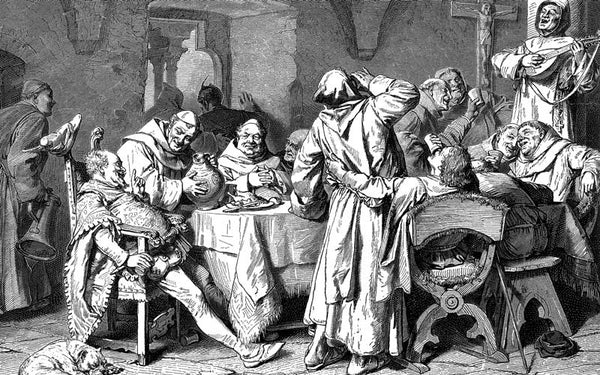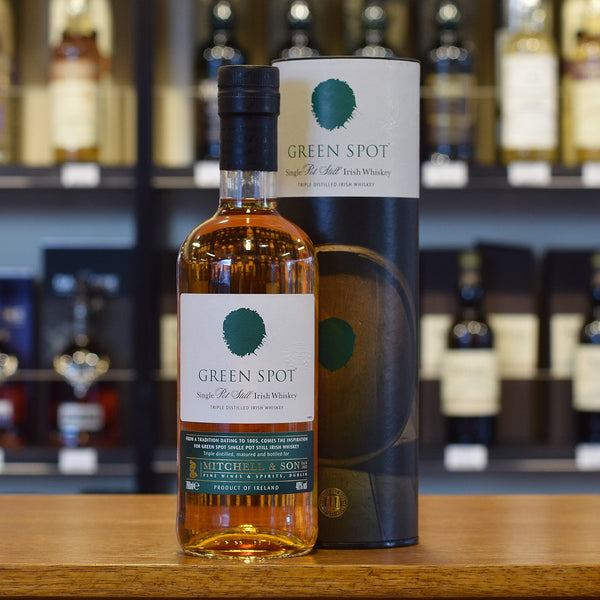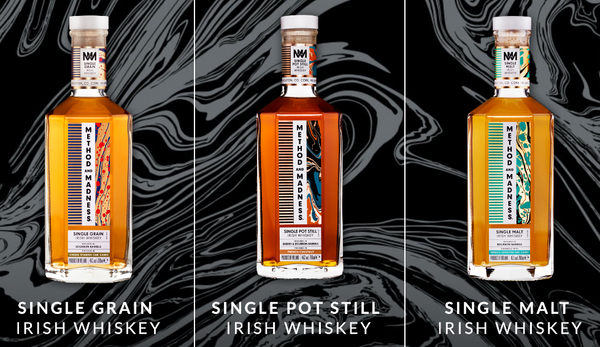The Willy-Wonka Distillery of Ireland - Midleton Distillery (Jameson, Redbreast, Spot Whiskey)
Distillery Spotlight: New Midleton Distillery
Region: Midleton, County Cork, Ireland
Note: Our Distillery Spotlight articles discuss how each distillery's unique process results in the distinctive flavour profiles of their whisky. To find out more about each step of the whisky-making process, check out our Basics Series article on how to distil the elixir of life.

We have covered stories from distilleries in Scotland, England and Japan. Most of these distilleries have self-encapsulated stories of how their unique location, philosophy and tradition gave birth to their signature distillery’s flavour profile and style.
Lest we forget, Ireland possesses a strong (if not the strongest) historical claim to the tradition of whiskey making. In the more recent centuries, the Irish have also come up with several distinctive styles of whiskey, the reasons deeply intertwined with the history of Ireland. Irish whiskey is well-known to be triple distilled and made from a mixture of malted and unmalted barley.

Today, we shall fly up to visit Ireland and learn about one of the most technically advanced distilleries in the world. Let’s have a brief history lesson on the Irish’s historical relationship with the water of life. Then, we will look at how the remarkable Midleton Distillery is single-handedly able to produce all the varied styles of Irish whiskey under one roof – essentially the Willy Wonka factory in the realm of whisk(e)y distilleries.
Brief history of Irish whiskey
Whisk(e)y is today more commonly associated with Scotland (some folks even use the term “Scotch” and “Whisk(e)y” interchangeably). However, according to one story, the Irish were the first to invent the aged spirit. After the English conquest of Ireland in the 12th century, the English observed that Irish monks were in the habit of making and drinking a strong spirit they call “water of life” or uisce beatha (pronounced ish-kay ba-ha) in Irish Gallic. The Scots and the English began drinking and distilling the stuff themselves. Uisce beatha was eventually corrupted into “whisk(e)y” by the English.

Although the most luxurious whiskies today tend to be Scotch (or Japanese even), the Irish whiskey was much more popular in the 1800s. Back then, Irish whiskey could be sold at a premium of many times a bottle of Scotch. Back in 1887 when historian Alfred Barnard chronicled The Whisky Distilleries of the United Kingdom, he visited 28 Irish distilleries and wrote that they were incredibly large and advanced at that time. Irish whiskey took up 70 percent of the world whiskey market! Two out of every three bottles of whiskey sold in London were Irish, and even in Scotland, Irish whiskey outsold Scotch whisky.

The decline of Irish whiskey – and birth of Irish Distillers Limited
The Irish whiskey industry declined from around 1919 to the 1970s (28 Irish distilleries dwindled to only 2 or 3). Only 3 Irish whiskey companies survived. Two are from Dublin- John Jameson & Son and John Power & Son- and Cork Distilleries Co. in Midleton County Cork.
At that time, Cork Distillers’ Midleton Distillery produced whiskey under the (1) Paddy brand.

John Powers and Son’s Distillery produced whiskey under the (2) Powers and (3) Tullamore Dew brand.


Jameson’s Distillery produced whiskey under the (4) Redbreast, (5) Jameson and (6) Green Spot brands.






To read more about the decline and rise of Irish whisky, check out our articles here and here.
Jameson, Powers and Cork join forces
It suffices to say that the Irish whiskey decline was thought to be as inevitable as Thanos at the end of Avengers: Infinity War – Part 1.
Faced with seemingly impossible odds of survival by themselves, the surviving three companies decided in 1966 to stop competing, join forces and found Irish Distillers Limited (IDL) to reverse the decline in Irish whiskey sales.
IDL then promptly chose a site near Cork Distillers Co.’s old distillery to build the ‘new’ Midleton Distillery. The old distilleries were decommissioned and all production was consolidated at the newly-built distillery at ‘new’ Midleton Distillery.
Making whiskey at Midleton Distillery

Whiskey-making at Midleton Distillery is both rooted in Irish whiskey tradition and commercial ingenuity. How is this achieved? This is where things get interesting.
There are three unique features of distillation practice at Midleton. Firstly, whiskey at Midleton are distilled three times in a pot still (“triple-distilled”). Secondly, unmalted barley and other grains are used in production. Finally, the unusually sophisticated equipment at Midleton Distillery can somehow be configured to produce distinctive flavours from three or four different distilleries.
The Irish practice of Triple-Distillation
In the Peaky Blinders TV series, flat cap-wearing gangster extraordinaire, Thomas Shelby, was said to prefer Irish whiskey over Scotch.

While the Scottish tend to conduct distillation twice, the Irish tend to do so three times, resulting in a sweeter whiskey with a texture that is lighter and smoother.
Why did the Irish use triple-distillation? It appears that this was a practice borne out of pragmatism rather than taste preference. During the 1800s, the Irish whiskey industry was enjoying a boom with Irish representing 80% of world whisky consumption. To keep up with the huge demand, Irish distillers kept increasing the size of their pot stills to Guinness World Record-breaking proportions. The largest stills in the world were all in Ireland, including a 110,000-litre monster at old Midleton Distillery.

While more efficient, these larger stills could not produce the same purity of whiskey obtained from smaller stills. Therefore, the Irish were forced to conduct triple-distillation which produced a finer, lighter spirit that still has the traditional creaminess of Irish whiskey. Over time, this lightness of texture has since became the distinctive flavour characteristic of Irish whiskey as did the practice of triple distillation. This practice of triple-distillation is also followed in modern day at Midleton Distillery.
So why did Thomas Shelby prefer Irish over Scotch? Back in the early 1900s, ice in beverage was a fanciful luxury for working-class Englishmen. Spirits had to be drunk neat. Working-class people in Birmingham (many of whom were Irish immigrants) reportedly preferred Irish whiskey over Scotch because they could not afford ice, and therefore wanted a lighter and smoother tasting triple-distilled whiskey.
The birth of Irish “Single pot still” using unmalted barley
The term “single malt” is often used by Scottish distillers- which indicates that their whisky is made from 100% malted barley (ie newly sprouted barley). In Ireland, whiskey was also originally made with 100% malted barley. However, in the late 1600s, the United Kingdom (which then included all of Ireland) was locked in conflict with France and had to fund military campaigns by taxing malted barley.
This imposed higher tax expense for traditional “malt whiskey” makers, because they are required to pay additional tax for each batch of malted barley they make for spirit production.
Ever the tax lawyers, the Irish who wished to cut down their malt tax expense came up with an ingenious solution. They realised that if they replaced up to 60% of their malted barley (taxed) with unmalted barley (tax-free), they could still create a very good spirit. Thus began the uniquely Irish tradition of combining malted and unmalted barley to create pot still whiskey that continues today. And because malted barley now only makes up about 30-40% of the grains used, they cannot label the resulting whiskey as “malt whiskey”. Instead, this is known as “pot still whiskey”, which is a key term of differentiation from the Scottish “malt whiskies”. This tradition has been codified as part of Irish law: under the Irish Whiskey Act, “pot still whiskey” must be made from at least 30% unmalted barley and at least 30% malted barley. This practice of making pot still whiskey is also faithfully followed at Midleton Distillery.
How different does pot still whiskey taste compared to ordinary malt whisky? The use of unmalted barley resulted in a whiskey with more notes of spice and pepperiness. The texture is also altered- much more full-bodied, viscous and creamy.
Midleton Distillery produces (1) single malt whiskey, (2) pot still whiskey, (3) single grain whiskey and (4) blends. Check out the chalkboard below which I have painstakingly drawn up to describe the differences:

Chalkboard A
Every flavour* is possible at the ‘new’ Midleton Distillery
You would recall that the three old distilleries originally produced 6 distinctive whiskey styles: (1) Paddy, (2) Powers, (3) Tullamore Dew, (4) Redbreast, (5) Jameson and (6) Green Spot.
The ‘new’ Midleton Distillery is also the world’s most technically advanced whiskey distillery. Opened in 1975, the ‘new’ Midleton Distillery produces all the whiskey formerly produced at above three distilleries. Check out the chalkboard below:

On top of the traditional brands, the distillery produces other new styles including (7) Midleton Very Rare, and (8) Method and Madness – a highly experimental range with outlandish combinations of ingredients and cask styles.


The ‘new’ Midleton Distillery thus produces more than 8 distinct flavours of whiskey under one roof, each time using slightly different distillation practices and different equipment settings. How? Firstly, its sophisticated stills can be configured with different settings to produce different types of distillates. Secondly, it has a very wide range of distilling equipment to produce different resulting whiskey (e.g. malt whiskey or grain whiskey). Thirdly, the availability different resulting whiskey allows for in-house blending to create different labels catered to consumers’ palates.
(1) Configurable stills. The Midleton’s stills can be configured to create distinctively different distillates. This allows the stills to re-create the traditional flavours of Paddy, Powers, Jameson etc. by mimicking conditions present in the former distilleries. This also allows for innovation - the stills can be configured to create a more modern interpretations of how Irish whiskey should taste like.
Depending on equipment settings, 4 different types of distillates can be created with the same pot stills:
- 'Light Pot Still'
- 'Medium Modified' (also known as 'Midleton Mod Pot')
- 'Heavy Pot Still'
- 'Traditional Pot Still' (a richer spirit made by capturing more of the latter part of the resulting spirit)
This provides a broad selection of different styles of pot distillates for Billy Leighton, the Jameson Master Blender to choose from.
(2) Different distilling equipment. Most distilleries like Glenmorangie or Macallan or Springbank use a single set of stills to create their product. Midleton has 3 sets. Large pot stills (for malt) and column stills (for grain) are used in combination to produce various blends of “traditional” Irish whiskey. In 2015, Midleton added several micro-pot stills specially for junior distillers to create more experimental products – including Method and Madness.



(3) Blending. While pot stills must be used to produce barley pot still whiskey, column stills are important for producing grain whiskey. Midleton’s possession of both pot stills and column stills allows the distillery not only produce pot still whiskey, malt whiskey but also grain whiskey (see Chalkboard A above). This point onwards, it is up to the distillery’s Master Blender to play around with different proportions to blend the ideal whiskey for consumers.
In the 1970s, the newly merged IDL desperately wanted to save Irish whiskey’s fortunes and gain widespread popularity with the general public. Their marketing consultants advised that the traditional Irish pot still whiskey has too spicy and biting a flavour profile for new drinkers to accept. Instead, the general public preferred lighter-style whiskey that can be achieved by blending pot still whiskey with grain whiskey. Grain whiskey is often used in blending because grain has much lighter and much fruiter ripe banana flavours, and helps smooth out the harsher characteristics of pot still or malt whiskies. IDL therefore decided to shift its focus from Irish pot still to blended whiskey which has a more approachable style. The legendary Jameson brand became a blended whiskey and several other brands followed suit. Only Redbreast and Green Spot remained as pot still whiskey brands.
Armed with a fruity peach and light cotton-candy sweetness, a signature soft, velvety mouth feel, and a consistent focus on advertising the Jameson brand, Jameson eventually is successfully turned from a specialty into a global brand.
The flavour profile of Midleton Whiskey
Midleton Distillery produces an incredibly diverse Irish whiskey styles with very different flavour characteristics. Yet a common thread through the 8 or 9 different labels is an underlying foundation of traditional Irish flavour.
Almost all whiskey from Midleton have elements derived from the Irish practice of triple-distillation and using unmalted barley. Their whiskey is almost always unpeated with a creamy texture, often carrying a touch of menthol, notes of fresh apples, cotton candy-like sweetness and a mild but distinctive spiciness unique to pot still whiskey.
Amongst the main labels, we can draw up some notable differences.
Jameson is the lightest-tasting and quite easily the most accessible of the family. Typical Jameson-labelled expressions tend to have the following taste profile:
Colour:
- White wine
Nose:
- Highly perfurmed and estery
- Light grassiness with fresh cut rosemary and mint
- Apples and filtered honey
- Lager beer with hops
Palate:
- Very fine, very light bodied and mild-flavoured
- Lots of vanilla
- Crisp and bright
- Juicy red apples and peaches
- Cotton candy
- Gentle spice creeping in
Finish:
- Short with fading spices and cotton candy

Redbreast-labelled whiskey is made in the most classic Irish pot still style, with both estery-light flavours and a uniquely viscous texture. Typical Redbreast-labelled expressions tend to have the following taste profile:
Colour:
- Deep amber
Nose:
- Vanilla and polished wood
- Toasted almonds and walnuts
- Sherried flavours of raisins and cranberries
- Moderate cinnamon
Palate:
- Estery light sweetness
- Silky and rich texture
- Clean and crisp vanilla and malt notes
- Sweet dark fruits such as raisins, cranberries and hawthorn candy flakes
- Toasted bread
- Moderately spicy undertones
Finish:
- Long with warming ginger spice and fading sweetness

Green Spot whiskey is also another classic Irish pot still whiskey. This one has a little more weight and earthiness. Typical Green Spot-labelled expressions tend to have the following taste profile:
Colour:
- Amber - Gold
Nose:
- Lots of vanilla
- Earthiness and dark ground coffee
- Desiccated coconut
- Dried apricots and banana chips
- Touch of oak
Palate:
- Very mild sweetness
- Oily texture
- Clean and crisp vanilla and malt notes
- Toasted coconut flakes
- Fennel seeds with growing spice
- Slight brininess
Finish:
- Long with warming spice, curry leaves and star anise

Our Take
Tasting a dram of whiskey from Midleton Distillery is probably the most enjoyable way to learn about the early Irishman’s commercial shrewdness. With its practice of triple-distillation to the use of unmalted barley, the distillery’s story and style of whiskey is inextricable from history of the Ireland.
We like that the modern Midleton Distillery offers something for both the old and the young. With the versatility of its high-tech equipment and highly skilled blenders, the distillery has the unique ability to simultaneously preserve tradition and innovate new styles of whiskey. Old recipes continue to be produced with the right settings and ingredients for those who remain nostalgic. For those who are more adventurous, the distillery is also passionate in radical experimentation and innovations to the whiskey-making process - from the use of different grains (eg unmalted barley, malted barley, corn or other cereals), to the use of different cask types for maturation. More practically, we love the fact that Midleton’s expressions are often very affordably priced as compared to Scotches or Japanese whiskey.

Our favourites are:
Entry Level: Jameson Irish Whiskey (Core); Jameson Black Barrel; Redbreast 12 Years Old (Core)
Moderate: Redbreast 12 Years Old Cask Strength; Redbreast Lustau Sherry Finish; Green Spot Chateau Montelena Zinfandel Finish
Top Shelf: Redbreast 29 Year Old- Dream Cask; Midleton Very Rare 46 Year Old

@charsiucharlie






